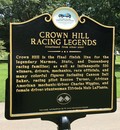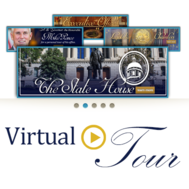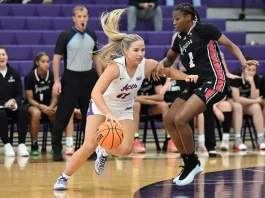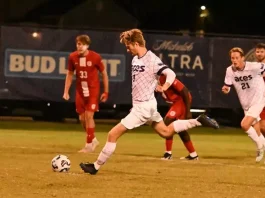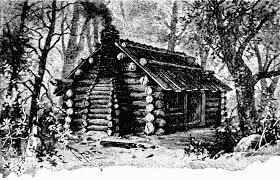 1802   William Conner established a trading post on the west fork of the White River in Central Indiana. He found success in the fur trade and in general commerce with pioneers and Native Americans.  A few years later, state commissioners met at the Conner cabin when they came to the area in search of a site for a new capital city. 1802   William Conner established a trading post on the west fork of the White River in Central Indiana. He found success in the fur trade and in general commerce with pioneers and Native Americans.  A few years later, state commissioners met at the Conner cabin when they came to the area in search of a site for a new capital city. |
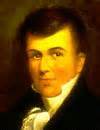
1816   In the first state election, Jonathan Jennings was elected Indiana Governor. He defeated Territorial Governor Thomas Posey. At age 32, Jennings was faced with the challenge of laying the foundation for the new state. In November, the new legislature met in the capital city of Corydon. Pictured: A detail from the official state portrait of Jonathan Jennings by artist T. C. Steele.
|
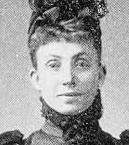 1903   Well-known journalist Mary Hannah Krout took time from her travels to visit friends on North Meridian Street in Indianapolis. Born in Crawfordsville, she traveled the world as a correspondent for newspapers in several cities, including Chicago and Denver. One of the first female reporters, she covered the major news events of her day. She was also active in the women’s suffrage movement. She published several books and helped compile and edit the autobiography of fellow Crawfordsville citizen, Lew Wallace. 1903   Well-known journalist Mary Hannah Krout took time from her travels to visit friends on North Meridian Street in Indianapolis. Born in Crawfordsville, she traveled the world as a correspondent for newspapers in several cities, including Chicago and Denver. One of the first female reporters, she covered the major news events of her day. She was also active in the women’s suffrage movement. She published several books and helped compile and edit the autobiography of fellow Crawfordsville citizen, Lew Wallace. |
 1923   An express train sped through the night of August 7 carrying the body of President Warren G. Harding. As it traveled from California to Washington, it passed through Northern Indiana. Thousands gathered along the route from Gary to Walkerton to Nappanee to Kendallville to St. Joe. In Goshen, 75 boy scouts stood at attention and sang “My Country ‘Tis of Thee.” At the Lake Wawasee station, a salute was fired by cadets of the Black Horse Troop from Culver Military Academy. Harding had died unexpectedly a few days earlier in San Francisco. 1923   An express train sped through the night of August 7 carrying the body of President Warren G. Harding. As it traveled from California to Washington, it passed through Northern Indiana. Thousands gathered along the route from Gary to Walkerton to Nappanee to Kendallville to St. Joe. In Goshen, 75 boy scouts stood at attention and sang “My Country ‘Tis of Thee.” At the Lake Wawasee station, a salute was fired by cadets of the Black Horse Troop from Culver Military Academy. Harding had died unexpectedly a few days earlier in San Francisco. |
1926   Charles Wiggins won the Gold and Glory Sweepstakes at the Indiana State Fairgrounds. The 100-lap, 100-mile event was held for African-American drivers who were not permitted to compete in the Indianapolis 500. Wiggins went on to win the Gold and Glory three more times. Born in Evansville, he was the son of a coal miner and became a skilled mechanic as well as winning driver.
 1946   Santa Claus Land, the nation’s first theme park, opened in Santa Claus, Indiana, in Spencer County. There were no roller coasters at first, but there was a House of Dolls, a train ride, a restaurant, and, of course, jolly old Santa Claus himself. The park grew each year and, in 1984, became Holiday World. 1946   Santa Claus Land, the nation’s first theme park, opened in Santa Claus, Indiana, in Spencer County. There were no roller coasters at first, but there was a House of Dolls, a train ride, a restaurant, and, of course, jolly old Santa Claus himself. The park grew each year and, in 1984, became Holiday World. |
Follow this link to subscribe to Hoosier History Highlights and to view archived editions
Follow us on Instagram: @instatehousetouroffice
|

 1802   William Conner established a trading post on the west fork of the White River in Central Indiana. He found success in the fur trade and in general commerce with pioneers and Native Americans.  A few years later, state commissioners met at the Conner cabin when they came to the area in search of a site for a new capital city.
1802   William Conner established a trading post on the west fork of the White River in Central Indiana. He found success in the fur trade and in general commerce with pioneers and Native Americans.  A few years later, state commissioners met at the Conner cabin when they came to the area in search of a site for a new capital city.
 1903   Well-known journalist Mary Hannah Krout took time from her travels to visit friends on North Meridian Street in Indianapolis. Born in Crawfordsville, she traveled the world as a correspondent for newspapers in several cities, including Chicago and Denver. One of the first female reporters, she covered the major news events of her day. She was also active in the women’s suffrage movement. She published several books and helped compile and edit the autobiography of fellow Crawfordsville citizen, Lew Wallace.
1903   Well-known journalist Mary Hannah Krout took time from her travels to visit friends on North Meridian Street in Indianapolis. Born in Crawfordsville, she traveled the world as a correspondent for newspapers in several cities, including Chicago and Denver. One of the first female reporters, she covered the major news events of her day. She was also active in the women’s suffrage movement. She published several books and helped compile and edit the autobiography of fellow Crawfordsville citizen, Lew Wallace. 1923   An express train sped through the night of August 7 carrying the body of President Warren G. Harding. As it traveled from California to Washington, it passed through Northern Indiana. Thousands gathered along the route from Gary to Walkerton to Nappanee to Kendallville to St. Joe. In Goshen, 75 boy scouts stood at attention and sang “My Country ‘Tis of Thee.” At the Lake Wawasee station, a salute was fired by cadets of the Black Horse Troop from Culver Military Academy. Harding had died unexpectedly a few days earlier in San Francisco.
1923   An express train sped through the night of August 7 carrying the body of President Warren G. Harding. As it traveled from California to Washington, it passed through Northern Indiana. Thousands gathered along the route from Gary to Walkerton to Nappanee to Kendallville to St. Joe. In Goshen, 75 boy scouts stood at attention and sang “My Country ‘Tis of Thee.” At the Lake Wawasee station, a salute was fired by cadets of the Black Horse Troop from Culver Military Academy. Harding had died unexpectedly a few days earlier in San Francisco.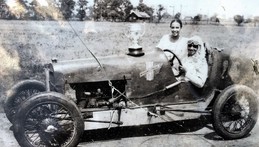
 1946   Santa Claus Land, the nation’s first theme park, opened in Santa Claus, Indiana, in Spencer County. There were no roller coasters at first, but there was a House of Dolls, a train ride, a restaurant, and, of course, jolly old Santa Claus himself. The park grew each year and, in 1984, became Holiday World.
1946   Santa Claus Land, the nation’s first theme park, opened in Santa Claus, Indiana, in Spencer County. There were no roller coasters at first, but there was a House of Dolls, a train ride, a restaurant, and, of course, jolly old Santa Claus himself. The park grew each year and, in 1984, became Holiday World.

